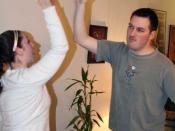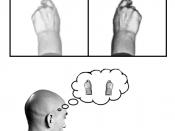During my observation, which took place February 24, 2000, from 10:00 to 11:00am, I observed an adult female with the speech disorder Aphasia/Aproxia.
What were the goals of this therapy session? There were two main goals in this therapy session. The first goal was to increase reading comprehension. The second goal was to increase and improve the use of multiple modalities such as, gestures, writing, drawing and use of the communications book. Overall the Speech and Language Pathologist wanted the patient to become comfortable with other means of communication, rather than having to rely on language one hundred percent of the time.
What were the therapy activities used to achieve each of these therapy goals? The first activity aided in improving reading comprehension. The object was to have the patient read a short composition and then answer questions about it. Next, the patient read two to three sentences and answered inferential questions on that as well.
The patient used the technique of underlining to help her emphasize key points in the compositions. This enabled her to recall and answer the questions with more ease. The next activity centered around improving multiple modalities. The patient selected a noun or verb from a piece of paper and had to effectively use a gesture, drawing or the communication book to communicate the word. Words such as watch, TV and microwave were used. They did about twenty trials of this activity and the patient was often required to use more than one modality per word. In the beginning of this particular activity the therapist knew the words that the patient was communicating. However, in the second part of this activity the therapist didn't know any of the words and had to guess what the patient was communicating.
List the material that were used when working on each therapy goal.
On the first goal of reading comprehension a worksheet was used. On the second goal of improving modalities a worksheet with a list of items the patient had difficulty representing was used. In this goal they also used strips of paper with nouns and verbs on them that were pulled out of a box.
What feedback was provided to the client by the clinician? During my observation I found that only positive feedback was provide by the clinician. The clinician gave feedback in the form of reminders to underline passages, the suggestion to try the modality another way and the demonstration of a new way to communicate the word that the patient had not yet tried. The feedback was both verbal and nonverbal. Verbal feedback included reminders and positive reinforcements such as "yes,"ÃÂ "good job,"ÃÂ and "right."ÃÂ Nonverbal feedback included nodding and smiling.
The clients cooperation and effort and the general quality of the interaction of the client and clinician.
The client was very cooperative and in general gave mostly "yes,"ÃÂ "no"ÃÂ and "I don't know"ÃÂ answers. However there were times in which the client seemed to get frustrated. When this happened I noticed that the therapist tended to give her the answer. I don't know whether this was beneficial to the client or not. It is possible that if the client got too frustrated she would no longer want to participate in the therapy sessions. However, it is also possible that by giving the client the answers to the questions, she is not learning anything. Overall, the session did seem to move very slowly. There were a lot of long drawn out silences during which the client was searching for a word or alternate modality. I also noticed that the clinician seemed to have an easier time guessing the words for the modalities than we, as observers, did. It is possible that because the clinician new the words prior to the session she may have been a better guesser than we were. It may have been beneficial to have an unbiased third party in the room to guess what the client was trying to communicate.
Overall this therapy session seemed to be extremely beneficial to the client. By learning other means of communication the client is not restricted to only using speech. With practice and perseverance the client will be able to improve her communication skills and thereby improved the quality of her life.





